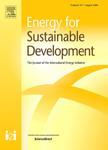版权所有:内蒙古大学图书馆 技术提供:维普资讯• 智图
内蒙古自治区呼和浩特市赛罕区大学西街235号 邮编: 010021

作者机构:Siemens AG Corp Technol Munich Germany Deggendorf Inst Technol European Campus Pfarrkirchen Germany Univ Cologne Inst Energy Econ Cologne Germany Tech Univ Munich Ctr Energy Markets Munich Germany
出 版 物:《ENERGY FOR SUSTAINABLE DEVELOPMENT》 (可持续发展能源)
年 卷 期:2021年第62卷
页 面:176-185页
核心收录:
学科分类:0820[工学-石油与天然气工程] 08[工学] 0807[工学-动力工程及工程热物理]
主 题:Rural electrification Mini-grids Microgrids Geo-spatial modeling Mini-grid business model Energy system development Mixed-integer linear programming
摘 要:There are currently more than 500 million people without access to electricity on the African continent alone. With an expected strong population growth and the global goals for reducing carbon emissions, the challenge of providing electricity for all is tremendous. We present an approach that tackles electrification bottom-up in a decentral approach from so-called electrification seeds: Business owners or public institutions that invest in an electricity system to ensure reliable electricity supply for themselves may serve as a seed by also selling elec-tricity in their surroundings via mini-or microgrids. This approach will allow for cheaper solutions due to economies of scale. While private households can also be addressed by simple solutions e.g. solar home systems, the power of the electrification seed approach is that it can also provide enough secure power for small and medium enterprises (SME) and thus drive economic development. It is important to address the individual environment of the respective electrification seed, since there is no standard solution. To do so, the method includes an entire toolchain from estimating demands and structures with satellite data and Geographic Information System (GIS) software over employing an energy system model for finding the optimal technological design. As a last step, the viability of the electrification seed concept is verified with an exemplary business plan. The results show positive business cases for the electrification seed and a reduction of electricity costs for end-customers by 11.3 %. Altogether, this gives a very optimistic outlook of the suggested approach to support the great challenge of sustainable electrification for economic growth in developing countries. (c) 2021 International Energy Initiative. Published by Elsevier Inc. All rights reserved.